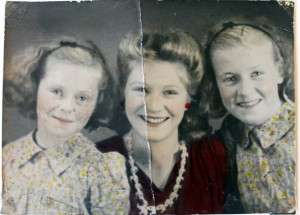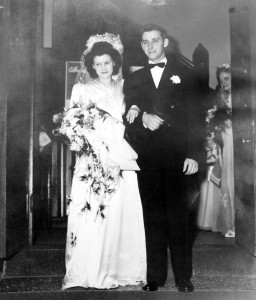GI Brides: Duncan Barrett and Nuala Calvi illuminate the phenomenon of Wartime Girls who crossed the Atlantic for Love
M.K TOD
 Nuala Calvi, half of the GI Brides writing team, discovered a few years ago that her grandmother had been married twice—the first time to an American GI. Keen to explore the story, Nuala and writing partner Duncan Barrett travelled to the United States to meet her estranged American family and to interview over sixty other British war brides. From those interviews emerged the lives of Margaret, Nuala’s grandmother, along with Rae, Sylvia and Gwendolyn.
Nuala Calvi, half of the GI Brides writing team, discovered a few years ago that her grandmother had been married twice—the first time to an American GI. Keen to explore the story, Nuala and writing partner Duncan Barrett travelled to the United States to meet her estranged American family and to interview over sixty other British war brides. From those interviews emerged the lives of Margaret, Nuala’s grandmother, along with Rae, Sylvia and Gwendolyn.
In World War II more than a million American soldiers landed in the UK as the Allies prepared for the invasion of France. With their bold, flirtatious ways, well-paying salaries and exotic accents, these GIs immediately attracted the attention of young British women. Meetings in factories and offices, teashops, military premises, and at Red Cross dances swiftly kindled relationships amidst the tense uncertainty of war. Not everyone loved the Americans; British soldiers were jealous, while many British parents feared their daughters would be jilted or worse. Love blossomed; impetuous marriages followed. By the end of the war, more than 60,000 women had married American GIs, causing the U.S. government to enact the War Brides Act to reunite these couples.
In many cases, women like those Duncan Barrett and Nuala Calvi write about in GI Brides sailed across the Atlantic to join husbands they hardly knew, leaving behind families, friends and everything familiar. They travelled for love, prepared to start a new life in a new land. Sadness mingled with anticipation, regret with excitement, nervousness with hope. What they found in America did not always meet their starry-eyed expectations.
In this non-fiction account, Barrett and Calvi tell the stories of four British women and the soldiers they married. Chapter by chapter Margaret, Gwendolyn, Rae and Sylvia let us into their lives. We follow them through the heady days of romance and courtship, the end of World War II, the long wait to join their husbands in the United States, the cramped, uncomfortable sea voyage, and the sense of dislocation they felt being far from home where customs and attitudes were so very different. And then we read how each woman attempted to settle into life with a group of strangers—their husband’s family and friends—and to deal with the inevitable challenges and disappointments.
 Originally from Ireland, Margaret works in London for ETOUSA (European Theatre of Operations – United States Army). There she “quickly discovered the effect she had on men”. After one failed relationship, she meets Lawrence Rambo, an American army captain and soon afterwards becomes pregnant. Once married to Lawrence, Margaret discovers that the charming captain, who had seemed so smart and capable, has a drinking problem.
Originally from Ireland, Margaret works in London for ETOUSA (European Theatre of Operations – United States Army). There she “quickly discovered the effect she had on men”. After one failed relationship, she meets Lawrence Rambo, an American army captain and soon afterwards becomes pregnant. Once married to Lawrence, Margaret discovers that the charming captain, who had seemed so smart and capable, has a drinking problem.
Rae is a tomboy. When war breaks out she enlists in the ATS (Auxiliary Territorial Service) and ultimately becomes a welder working in various factories producing war materials. Rae distrusts the Yanks, and when a tipsy GI shouts, “Oh, look, it’s the ATS—the American Tail Supply,” she walks straight up to the man and socks him on the jaw. Nonetheless, Raymond, a US Army cook, breaks through her defences and reluctantly she agrees to go out with him. After they marry, Raymond heads to France with the D-Day landings. As time unfolds and Rae follows Raymond to America, she discovers that he is not the happy-go-lucky man she thought she had married and troubles ensue.
 When we first encounter Sylvia, she’s helping out at the American Red Cross where GIs gather to socialize and dancing occurs almost every night. Sylvia is fifteen and a half. The first man she falls for dies in the D-Day landings and sometime later, just as the war is ending, she meets Bob. Before the couple can marry, the Army sends Bob home, but the US War Brides Act does not include fiancées and the couple must save the money for her transportation. Once in Baltimore, Sylvia discovers to her dismay that her husband’s favourite activity is gambling.
When we first encounter Sylvia, she’s helping out at the American Red Cross where GIs gather to socialize and dancing occurs almost every night. Sylvia is fifteen and a half. The first man she falls for dies in the D-Day landings and sometime later, just as the war is ending, she meets Bob. Before the couple can marry, the Army sends Bob home, but the US War Brides Act does not include fiancées and the couple must save the money for her transportation. Once in Baltimore, Sylvia discovers to her dismay that her husband’s favourite activity is gambling.
Gwendolyn is a shorthand typist for the Southampton Chamber of Commerce in 1943 when the US army takes over that port city. Hundreds of American officers are billeted at the Polygon Hotel directly across the road from her workplace. Although her first crush is a married man looking for companionship, shortly after D-Day she watches Ben Patrino stand up for a group of RAF men disfigured by burns who had been turned away from a local restaurant. That encounter eventually leads to marriage and life in California.
Collectively these women experience adultery, addiction, severe money problems, miscarriages, unfriendly in-laws, life-threatening illness, isolation, and abuse. The stories of how they coped and how their lives evolved are candidly and compellingly told in GI Brides.
Calvi and Barrett have chosen strong, independent women as subjects—women who were prepared to stand up for themselves when necessary and make difficult life choices. Each one struggled; each one eventually found support from family and friends. And they all found a touch of home in one of the war bride associations that sprung up across the United States. These associations, active in a number of countries around the world, provided a lifeline to so many, a place to congregate with women in similar circumstances, to share stories of home, seek advice, and find friends. Even now, the World War II War Brides Association has more than 500 members and affiliated chapters across the United States.
About the contributor: M.K. Tod writes historical fiction and blogs about all aspects of the genre at A Writer of History. Her latest novel, LIES TOLD IN SILENCE is set in WWI France and is available in paperback from Amazon and in e-book formats from Amazon, Nook, Kobo, Google Play and iTunes. Mary can be contacted on Facebook, Twitter and Goodreads.






